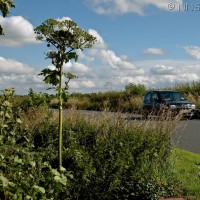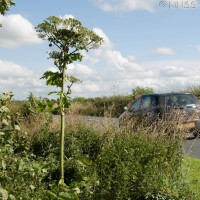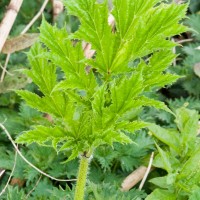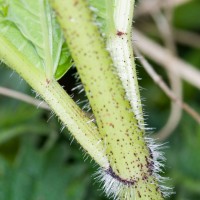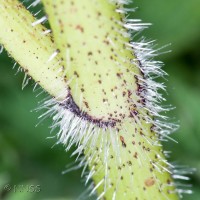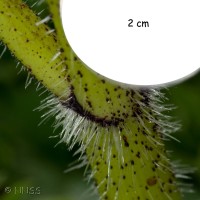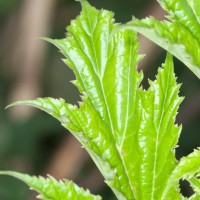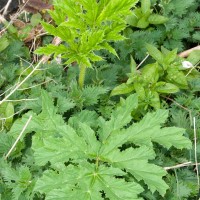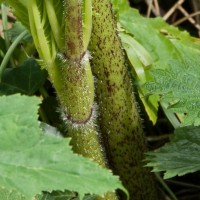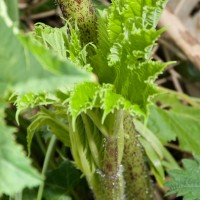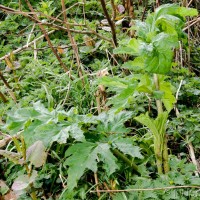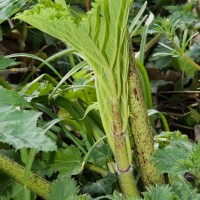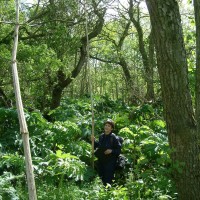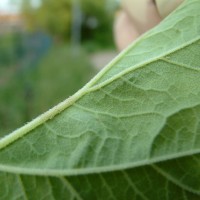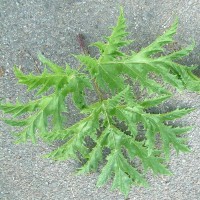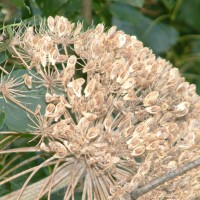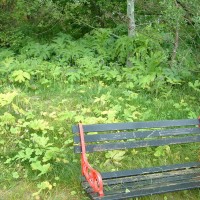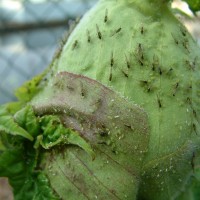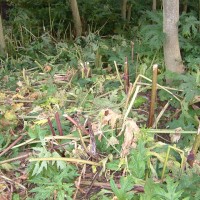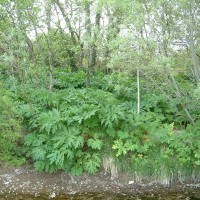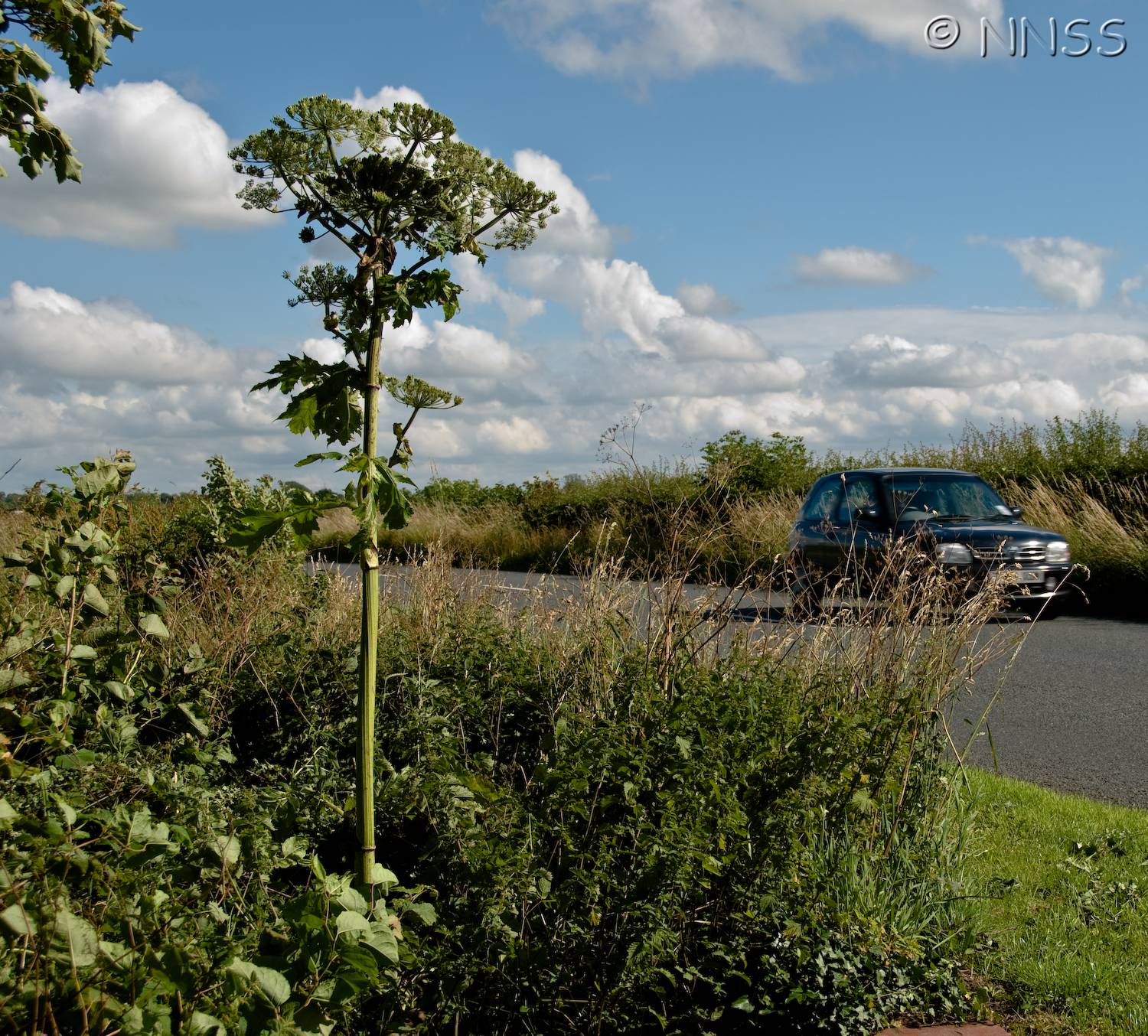
Giant Hogweed - Heracleum mantegazzianum
Expand and collapse the sections below by clicking on the title or + / - icons.
Short description of Heracleum mantegazzianum, Giant Hogweed
Aptly named ‘giant’, this umbellifer (member of the cow-parsley family) has flowering stems typically 2-3 m high bearing umbels of flowers up to 80 cm in diameter. The basal leaves are often 1 m or more in size.
Impact summary: Heracleum mantegazzianum, Giant Hogweed
The sap can sensitize human skin to ultra-violet light, leading to severe blisters. Affected skin may remain sensitive for several years. The plant is also a vigorous competitor, producing almost pure stands which exclude native vegetation and hinder anglers.
Habitat summary: Heracleum mantegazzianum, Giant Hogweed
It is especially abundant by lowland streams and rivers, but also occurs widely on waste ground and in rough pastures. It grows on moist fertile soils, achieving its greatest stature in partial shade. In more open grassland, flowering may be delayed by repeated grazing.
Overview table
| Environment | Terrestrial |
|---|---|
| Species status | Non-Native |
| Native range | Azerbaijan, Gruziya |
| Functional type | Land plant |
| Status in England | Non-Native |
| Status in Scotland | Non-Native |
| Status in Wales | Non-Native |
| Location of first record | v.c.29 (Shelford) |
| Date of first record | 1828 |
Origin
South-West Asia
First Record
First recorded in the wild in 1828 in Cambridgeshire.
Pathway and Method
Introduced to gardens as a monumental curiosity by 1820, and was deliberately planted by rivers and ponds.
Species Status
Widespread and well established in lowlands across England, Scotland, Wales and Northern Ireland. Has been spreading rapidly, despite control measures.
Dispersal Mechanisms
The species reproduces entirely by seeds; fruits are oval-elliptical broadly winged mericarps (6-18 Ć 4-10 mm), which are dispersed by wind, water and humans.
Reproduction
The species is monocarpic, that is, it reproduces only once in its lifetime. Plants are able to self-fertilize. A single plant produces about 20,000 seeds which have to be stratified in the soil in cold and wet conditions during winter and then are highly germinable.
Known Predators/Herbivores
Insect or pathogens have little effect. Grazing by livestock can significantly decrease the reproductive output but also prolong the lifespan before flowering.
Resistant Stages
Seeds form a short-term persistent seed-bank; the majority of them germinate the following year after release and only about 1% of seeds are able to survive more than 3 years in the soil.
Habitat Occupied in GB
Lowland habitats.
Native Range
Western Greater Caucasus.
Known Introduced Range
Covers temperate Europe (with distribution clearly biased towards central and northern part of the continent) and parts of North America. Other invasive relatives, H. sosnowskyi and H. persicum, occur in northern and eastern European countries.
Environmental Impact
The species may form dense stands reducing species diversity.
Health and Social Impact
The plant produces phytotoxic sap. The sap contains photosensitizing furanocoumarins, which in contact with human skin and combined with UV radiation cause skin burnings. The intensity of the reaction depends on individual sensitivity. The danger to human health complicates eradication efforts.
Economic Impact
None known.
Identification
Biology, ecology, spread, vectors
Management and impact
General
Spotted this species?
Distribution map
View the Distribution map for Giant Hogweed, Heracleum mantegazzianum from BSBI

Native range map
View an interactive native range map for Giant Hogweed, Heracleum mantegazzianum
Management
Links to management practices for Heracleum mantegazzianum. See all management information.
Legislation
This species is:
- A Species of Special concern
- Listed under Schedule 9 of the Wildlife and Countryside Act 1981
Read more about Non-native species legislation.

